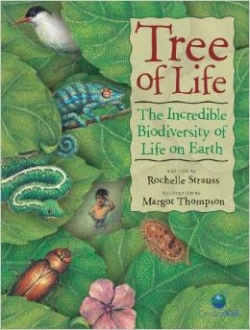- Home
- Tutorial
- Resource Guides
- Focus Areas
- LSF Programs
-
Professional
Development - Review Process
-
A project of LSF

Search for Resources
Description
This non-fiction book provides a fascinating introduction to the way we classify and sort the millions of living organisms found on our planet. Ecological interdependence is visually represented by a single tree and students will be surprised to discover that while humans are only one leaf among millions, our species poses the largest threat to biodiversity. With rich illustrations and informative text, this book makes a great addition to any science classroom while also encouraging readers to make wise environmental choices that help sustain all life on Earth, including ours.
Click here for more information regarding the author's books, school visits, or teaching resources.
General Assessment
Recommendation of how and where to use it
This book offers a great introduction to taxonomy and the Linnaeus classification system while incorporating an environmental message that focuses on ecosystems and biological diversity. Several species are singled out in the text for the natural services they provide. Students could learn more about the role of plants in providing food and medicine by exploring an outdoor habitat with a community member who can share their traditional knowledge. A class could also collect invertebrate specimens from a feature like a rotting log and build science skills by preparing scientific drawings of each species.
Students could undertake a community awareness program that promotes the value of biodiversity with a large replica of the "tree of life" surrounded by messages about environmental stewardship. This campaign could also lead to an action project where a class actually creates an area of wildlife habitat like a pollinator garden or shallow pond.
Relevant Curriculum Units
The following tool will allow you to explore the relevant curriculum matches for this resource. To start, select a province listed below.
- Step 1Select a province
- Alberta
- Step 2Select a grade level
- Grade 4
- Step 3Select a subject
- Science
- Step 4Relevant matches
- Earth Systems: Understandings of the living world, Earth, and space are deepened through investigating natural systems and their interactions.
- Grade 6
- Step 3Select a subject
- Science
- Step 4Relevant matches
- Living Systems: Understandings of the living world, Earth, and space are deepened through investigating natural systems and their interactions
- British Columbia
- Manitoba
- New Brunswick
- Step 2Select a grade level
- Grade 4
- Step 3Select a subject
- Science
- Step 4Relevant matches
- Properties and Uses of Earth Materials: Learning and Living Sustainably
- Grade 6
- Step 3Select a subject
- Science
- Step 4Relevant matches
- Science 6 Wayfinding: Making sense of your world: Scientific Literacy
- Wayfinding: Making sense of your world: Learning and Living Sustainably
- Newfoundland & Labrador
- Northwest Territories
- Nova Scotia
- Nunavut
- Ontario
- Step 2Select a grade level
- Grade 4
- Step 3Select a subject
- Science & Technology
- Step 4Relevant matches
- Life Systems: Habitats and Communities
- Grade 6
- Step 3Select a subject
- Science & Technology
- Step 4Relevant matches
- Life Systems: Biodiversity
- Prince Edward Island
- Quebec
- Step 2Select a grade level
- Grade 4
- Step 3Select a subject
- Science & Technology
- Step 4Relevant matches
- Living Things
- Grade 5
- Step 3Select a subject
- Science & Technology
- Step 4Relevant matches
- Living Things
- Grade 6
- Step 3Select a subject
- Science & Technology
- Step 4Relevant matches
- Living Things
- Saskatchewan
- Yukon Territory
Themes Addressed
Ecosystems (4)
- Biodiversity
- Endangered Species
- Habitat Loss
- Interdependence

